This post was submitted by BikePortland subscriber Kiel Johnson of Go By Bike.
Today, as children around the world were discovering what was inside of the wrapped boxes under their Christmas tree (or however else they celebrate the holidays). I did the same thing I do most days. I rode my bike around. Except this time Santa gave me the greatest gift of all. A city devoid of cars.
“The city was stressless and it was amazing.”
What was most remarkable was how quiet the city was. Everyone I passed commented on this. The city was stressless and it was amazing. It reminded me of a picture hanging up in our building from when the Lloyd Center mall was first built. Next to the mall you can see I-84 on a 1960’s weekday afternoon. There are so few cars you could count them on one hand.
Advertisement
When the planners decided to build a freeway on valuable riverfront real estate or fill downtown with auto-parking, they did it in a city that felt like the one I was riding in, not the relatively oppressive city we are in today. Of course you would want to build a freeway back then. They had no idea the urban loss and social value being sacrificed to these structures. You only begin to understand the scale of this sacrifice when it is gone.
Today riding around I realized what we gave up. What a city can feel like when it isn’t overrun by car traffic.
Here are a few more photos…
Do you want to see your story and photos here on the Front Page? All you have to do is subscribe!


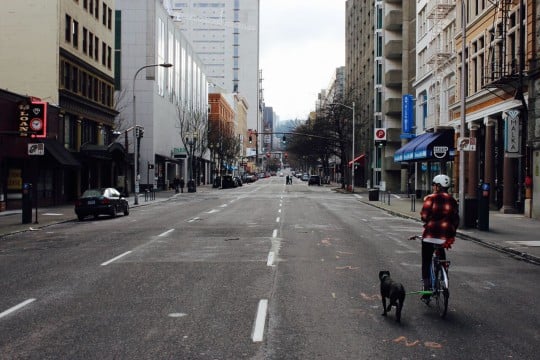
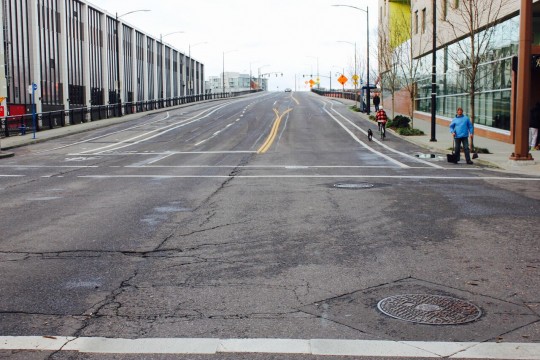
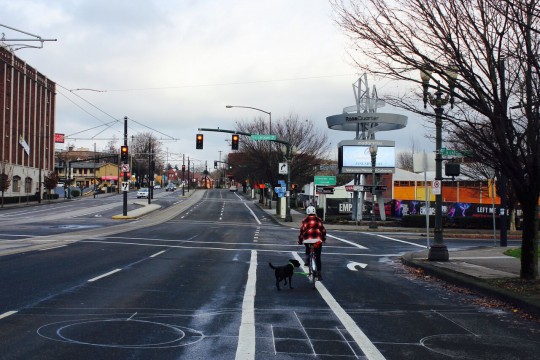
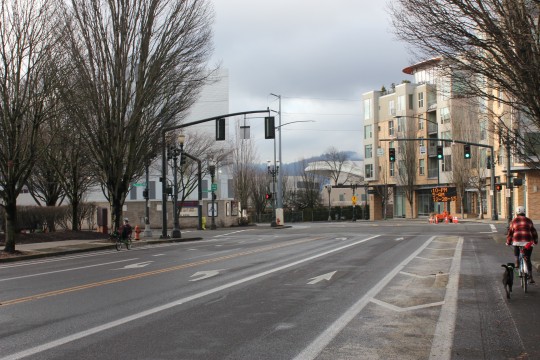
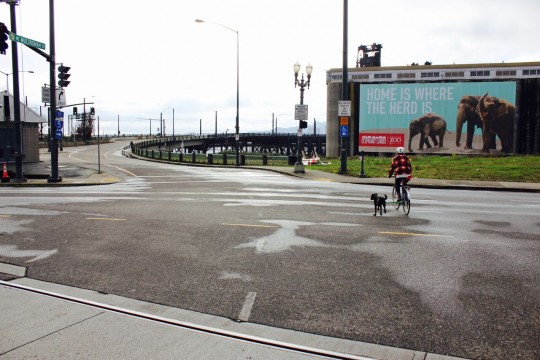
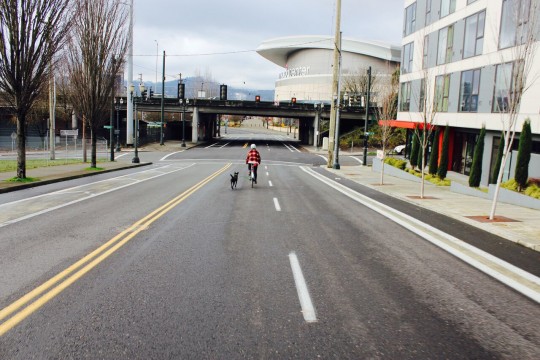
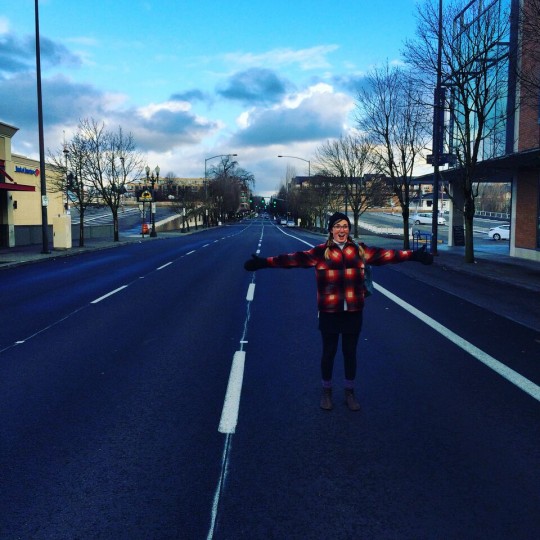

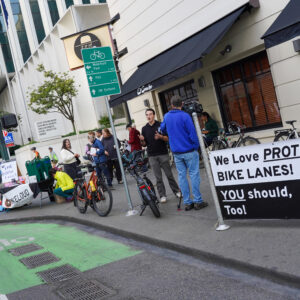
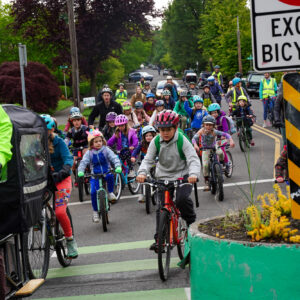
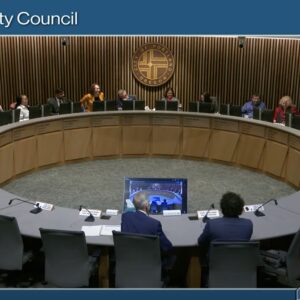
Thanks for reading.
BikePortland has served this community with independent community journalism since 2005. We rely on subscriptions from readers like you to survive. Your financial support is vital in keeping this valuable resource alive and well.
Please subscribe today to strengthen and expand our work.
Wasn’t it nice? I rode to my sister’s for Christmas breakfast, and saw hardly a car the whole way. Lots of folks out walking, too, since the weather was so bright. Actual sunshine!
Of course, since the entire fam is either exclusively or mostly bike-ped, we did end up swapping traffic horror stories over the coffee and cookies. The bite that car culture took out of Portland in the mid-20th century seems to have suddenly gotten deeper just in the last year.
Nevertheless, on a Christmas day like today, we had a reminder of what city life might be again, and it was lovely.
Portland is on the cusp of something great. It could be the city that takes a stand and starts to really remove lanes, allows no more than 1 lane each direction for cars, allocates lanes to transit city wide, paints in and buffers real bike lanes….
Of course, it will have to face down the vocal minority that demands the right to travel everywhere by heavy rubber and steel while mowing down people and bikes with little consequence.
We must change. Christmas proves we can.
I would love that. Unfortunately, it’s a vocal majority that we’re up against.
We need to spread the word about induced demand and reverse induced demand. See below paper from earlier this year for an excellent review of the subject. Every transportation advocate should be famiiliar with this subject so they can challenge misguided projects and inform the public. Adding lanes and LOS “improvements” divides local neighborhoods, killing local business, and induces automobile mode demand causing congestion. Removing lanes and certian LOS driven infrasturcture works in reverse, strengthening local communities, and can even reduce congestion over 3 to 5 years. Congestion is now understood to be mosty an econmics issue, strongly tied to zoning practice, and tends to remain constant with regard to transportation projects. The future of congestion relief is through better mixed zoning practice, congestion pricing, market value parking rates, and removing boundaries that separate local neighboods from local retail and local workplaces.
http://www.vtpi.org/gentraf.pdf
Thanks Tom – LOS is exactly what I thought of when I read this first comment. Has Oregon officially moved to VMT standards yet? I know California has, but we are only starting to see it trickle into EIRs, and even then it’s only a mention before all the LOS impact tables from new developments. I don’t think planners or developers know any other way, but they’re coming around – one big development we’re following in our city is striving to be pedestrian and bicycle friendly by putting a “mall” down the middle, and fixed some of the conflicts in the feeders with auto overpasses. Still haven’t addressed how people actually get there by bike, but they don’t seem to believe that’s their problem.
I don’t suppose you guys would mind dropping the three letter acronyms? I’m pretty interested in the discussion, but using jargon can get in the way.
Thanks!!
Good call, Jason. To translate:
“VMT” stands for “vehicle miles traveled” and means “miles driven by motor vehicles.”
“LOS” stands for “level of service” and means “speed at which traffic can get through a given intersection.” Lots of cities (though happily not Portland) enshrine this measurement as the most important goal of their transportation systems.
I think “EIR” stands for “environmental impact review” and means “documentation required by California state law that assesses the external effects of new building projects.”
If you’re interested, this is a pretty good explanation of the California policy Pete mentions:
http://www.citylab.com/commute/2014/07/transit-projects-are-about-to-get-much-much-easier-in-california/374049/
Thanks, and sorry all, old habits die hard. Got the memo, and next time I promise not to forget the cover sheet on the TPS report.
https://www.youtube.com/watch?v=Fy3rjQGc6lA
I’ll second that request!
It doesn’t matter if they are a minority or majority. Just because the city is one way doesn’t mean that way is the best way. I’m hopeful that someday we have real political leadership to lead people to realize what a better city Portland can become.
I took a ride around the new Tilikum bridge to see if there was anyway I could incorporate it into a commute of any kind….
It feels amazingly busy, congested and confusing on a Holiday.
Don’t let the planners of this mess have anything to do with the future you envision..
We took out of town guests to stroll Tillicum Crossing and ride the Tram, so we were part of the tourists wandering about.
Lots of tourists strolling and viewing. Not typical for commuting. Even for commuting it requires a more casual approach to riding than riding on the street. More like the separated paths of Europe.
Bend is too icy for riding, so I walked over 7 miles yesterday. I walk a lot anyway, since I am afraid of riding in the land of ‘everyone has an SUV and talks on their phone’. I was truly amazed how different my town is without cars. I started around 9 am, and I would guess traffic was around 10% of normal. No anxiety trying to cross the street, no constant noise. I had already decided that I wanted to move to a smaller town, with less traffic, and this confirmed it for me.
I think people are on their phones less here than elsewhere. I also find traffic really reasonable relative to the size of town, but there’s also a lot of subjectivity to how people see traffic.
You’re probably right; it’s just that I’ve been here since 1980 when it was a small town. Probably skews my view. Cellphone usage is down the past year, although I see drivers have adapted by holding their phones in their laps and using the phone on speaker.
I believe that you’re incorrect in reasoning why people don’t have their cellphones up to their ear. It’s evolved to a more dangerous phase, where people are talking less, and texting/using the internet more and more.
Their eyes are now more aimed down low to the car’s lower console, looking for new distractions, instead of looking ahead. I see this so often when stopped at an intersection and looking at what drivers are up to.
Copenhagen is a larger city than Portland but it feels like a small town everyday. Remarkable how quiet a city it is. I’d move there before a small US town!
I wonder if it’s a tourist town thing. This is something that disappoints me about Hood River, where I used to live and still spend a great deal of time. I see far more drivers talking on cell phones here than in Santa Clara where I moved in 2009. (Unfortunately in silicon valley they’ve taken to stopping in the bike lanes to text and talk, thinking they’re doing the right thing).
Streets are still nice ‘n’ quiet today, so far. Just like in the picture above, all the bikes I saw are in bike lanes or holding far right, despite the lack of cars.
Thanks for the photo updates. Take the lane! 🙂
Own it… you paid for it! 😉
Sounds a lot like MTB riding around town during the last big snowstorm – nobody out, extremely quiet, very peaceful. It was amazing.
I have noticed an uptick in traffic and overall rudeness of drivers in the past few years, and days like this remind me of the peaceful alternative.
Hopefully the city can move things in the right direction.
I loooove snow storms. Not because I like snow; I prefer my water in liquid form. However, I just adore the relative quiet at the car-bound either stay home or drive slowly through the mush. It makes me wonder just how much noise reduction would be achieved by a 15 mph speed limit on all surface streets. Of course then we’d all want to cover those awful freeways.
I was reading “Streets Were Not Built For Cars” and found this quote interesting. Referring to around the year 1900:
“Portland, Oregon, had a turn-of-the-century network of 59 miles of six-foot-wide cycle paths,”
Whatever came of this? Where did this network go? Is there a map somewhere? If so could it be used to plan a network again?
Interesting. A few years ago I found a map of California’s bike roads from the same era. I had a digital copy, but I foolishly hadn’t backed it up so when that computer failed it was lost to me (until I get off my duff and go find it again).
You can read more about it here – it flourished briefly, but fell into disrepair and neglect very quickly as wealthy early adopters moved on to the auto.
https://fortunaerota.wordpress.com/2008/02/25/pdot-bicycle-brown-bag-feb-21/
https://fortunaerota.wordpress.com/2010/12/30/when-the-suffrage-truck-replaced-the-bike-changing-views-1895-1912/
Hey Clark,
This link has the 1896 Cyclists Road Map of Portland from the Oregon Historical Society. It used to be available to buy as a poster, but I couldn’t find anything about that at the OHS site.
http://maplib.blogspot.com/2011/05/1896-cyclist-road-map-portland.html
D
Great book, especially for history buffs!
And women couldn’t vote. Society advances.
“Society advances.”
Automatically?
I don’t think I’m following your point.
Is this it?
http://www.loc.gov/item/97683587
Thanks. That looks very much like it.
I love the rail lines shown on this one. Some of the ones that are currently missing bring back some old stories I heard long ago.
The photo is interesting. If that’s a buffered bike lane, why aren’t there so much as flexible bollards to keep cars from coming over? It strikes me that the city is sending a tacit message of “if you need to use the bike lane…use it”.
So even on this street, they just went 95 percent.
I’ve experienced similar solitude riding late evenings in the downtown and Pearl District areas. This past summer (I like warm weather…) I’d go out on my bike at around 9 PM on weeknights and, for the most part, cars were scarce. Lots of people walking around from restaurants and pubs, and with the relatively bright street lights it felt safe.
Not a day goes by that I don’t bemoan the ugly intrusiveness of the automobile in our daily lives. I enjoy urban photography and sonography (audio field recordings), both of which are severely limited (mostly ruined) by the omnipresent car.
You folks hate the automobile. I hate the phone. Cars are more fun than any pseudo adventure involving your phone. The streets are empty due to folks enjoying their life instead of going to work. Maybe everyone should hate working so much. If you folks really want safety and solitude while riding a bicycle head to the trail.
Don’t you love the whole meal – entree, sides, beverages and dessert? I love bikes and cars and transit and walking. Presentation, balance, contrast, compliment and pairings make all the difference between just “filling” and a great meal…or transpo system. (scale, hierarchy, sequence…)
Happy trails!
I love driving cars as well! My parents live out on an island in the San Juans and few things beat driving around in a turbo passat stick shift. But me driving around makes it less enjoyable for people taking a walk or gardening next to the road. In a city there are a lot more people outside or in building that can hear traffic. Having the vast majority of people (who are also affluent enough to afford cars) driving around takes away enjoyment from everyone else. Building a city around automobiles creates a lot of hidden externalities which do not get taken into account.
I don’ think his point was that he loves driving (he never says he loves driving). His point seemed to be that more people should be enjoying their lives instead of working all the time or having to a own a car to drive to work or stuck with their head in their phones.
Ahhh…you found yourself a way to the dark side. Welcome! I used to believe like you, listened to conservative radio….hates bike lanes and despised urbansim. Welcome! Pull up a chair, read some posts and learn. You might, after a few years, come around.
Nobody hates the car here. What info dislike is the overuse of the car and how we are forced to use it. That’s the issue sir.
I hate the car. I’d uninvent it if I could. 🙂
If you actually knew me…I had three friends call me on my landline to inform me of your “mission”. Wow! Thanks for the chuckle. I have spent more time on a bike than you will for the entirety of your life. I have to remind myself that very few of you ride. When you folks can properly fit a helmet to your head, or utilize proper fenders when necessary, I will still question the “I just moved to Portland” approach that is so popular with so many of you who know better on this transportation forum. Portland was a far better city before most of you arrived. Have a nice time staring at your phone. Get it? I don’t hate bike lanes, but I prefer to ride with traffic.
I also hate the car. It’s deadly, causes pollution, destroys cities, sucks away money, and turns otherwise nice people into raving psychopaths. We’d all be much better off without them.
Interestingly I watched a piece on history channel the other day that showed a lot of movies and still shots done around 1900 when nearly every large city had an electric trolly system. There were a lot of bikes (even big wheels). Later there were a few cars but very few as everyone took the street car and bicycle once the horses were sent to pasture.
Then the street cars began to disappear and stinky busses began taking their place. The transition was nearly complete in the early 50’s when it was realized that representatives from one company had filled all of the municipal transportation trusts in the U.S. This company was controlled by BM (making the Busses) Standard Oil (Making the diesel), amongst a few others. They were charged with a monopoly, fined and disbanded before 1960.
I think the old nemisis to sensible renewable transportation has been raising their heads the last few years.
Just my opinion!
Yeah, so tru
I don’t know about others, but i really despise cars. There really isn’t anything to “love” about them.
Anyone who despises polluted air, polluted water, death and suffering should really despise the automobile, because it is the #1 cause of all these things.
See the layer of smog starting to develop in the Willamette Valley? That’s because of cars. Don’t believe me, bike over the Ross Island bridge on a warm day and breathe deeply.
Ever been to the emergency room? 75 to 80 percent of ER or ICU patients are there because of cars. Don’t believe me, ask a trauma nurse.
About 50,000 people die every year in the USA because of cars. That’s more than guns, war or disease.
… and so on.
Fact is, anytime we go on about the virtues of the automobile, how convenient or efficient it is or whatever, we’re engaging in major cognitive dissonance.
I myself, just want car drivers to take a second to acknowledge this.
Then they can go back to polluting our city and making it less safe for everyone who lives in it.
Merry Christmas!
What if cars were all autonomous (and they figured out how to make it so 99.9% of the time they didn’t crash), put underground, and all ran on electric energy from solar panels? That sounds like a transportation I could get behind. It would allow people to travel quickly if they wanted to, be safe, little pollution, and free up space in the city for people.
No thanks. A pipe dream and a diversion from the real work of weaning ourselves, recognizing the impossibility of fixing this and still coming out the other end with our planet intact. Emissions and carnage are, after all, not the only problems with our transportation priorities.
But I agree with your other posts here and the great photos of our city in a rare moment free of the auto.
We already have that. It’s called a subway.
I myself, just want car drivers to take a second to acknowledge this.
i am a car owner and i refuse to acknowledge this because my car does not have a tail pipe and is charged with renewable offsets. i personally have zero need for a car but i bought one to decrease my cohabitant’s CO2e, to support the used EV market, and to be a symbol for immediately feasible change. in fact, there is almost perfect overlap between my motivation to ride my bike for transportation and my motivation to own a car!
Unfortunately, I only own a car to ride a mountain bike.
You can thank the “environmentalists” for that!
Free Forest Park.
The “environmentalists” forced you to live in a place without mt. bike trails? There’s places all over the country where you don’t need a car to ride a mt bike. It’s your priorities that force you to have a car, no one else’s.
Exactly my point – why are there places all over the country that have mtb trails, but not Portland?
Your argument is ridiculous (and kind of condescending). Of course no one forced me to live here (other than I do have a job that requires me to be in Portland), but the fact that we have the largest city park in the country and less than .5 miles of single-track available to mountain bikes is ridiculous and their “environmentalism” is not so much for the environment – it is more NIMBYism than anything. I would suggest familiarizing yourself with the local politics around this one.
People can and do share trails all over the world – just not in Portland – and it is time for us to recognize that, grow up, give bigger environmental and health concerns higher priority and try to cut down on car usage/creating CO2 than to support NIMBYism in Portland.
Putting forth the argument that Portland owes anyone mountain bike trails is, in my opinion, ridiculous. Especially when there are so many miles of world class trails within a minor commute of the city.
What is condescending is your assumption that others are not as familiar “with the local politics around this one” as you may be but each to their own, I guess. I just don’t agree with your premise that PDX owns anyone mountain bike trails.
More so, based on the level of trail damage that I see when we do periodic trail maintenance outings – I’m not sure I agree that environmentally sound trails could be maintained in Forest Park considering how much use they’d get, be it through erosion or outright vandelism.
Putting forth the idea that a large group of users should be excluded from Parks based on a vocal minority to me is ridiculous, especially when it is not justified in science.
Based on your knowledge of trail building, I would say your ignorance is high. I have done much trail building (including in Forest Park) and damage can all pretty much be mitigated through good engineering – which the trails in FP are not.
But overall, you are right – no one owes anyone anything. So let’s just shut down everything to everybody. Seems legit. Let’s kick bikes off of streets – they were built for cars anyway…
The worst is when you see an entitled user group who has all the access to everything calls the one that doesn’t have access “entitled” because they want a slice. That’s not entitlement, that’s call sharing.
Well, you sound like a pretty wonderful person. Enjoy. I’m off to ride.
It sucks when someone else takes your arguments to their logical conclusions, doesn’t it?
Happy New Year!
Wait, so you’re saying that trails in FP would be used a lot, but that people don’t have a right to demand facilities that they want/will use?
We are just acting _so_ entitled by expressing our interest in having trails in FP and then participating in a democratic process to how we want the park to be used only to have the rug pulled out from under us after the majority of users voted in favor of more trails…kind of reminds me of RVNA, or what’s going on at Tualatin Mtns with Metro, or Timberline…
“so many miles of world class trails within a minor commute of the city”
Where is that?
Since you’ve unfortunately chosen to introduce the question of mountain bike enthusiasts’ desire to use Forest Park for mountain biking, into a discussion of the absence of traffic in Downtown Portland on Christmas Day:
All indications are that Forest Park is free of vehicular recreation use because except for a small group of mountain bike enthusiasts in the city apparently feeling otherwise, Portland residents believe it’s important that this nature park’s trails continue to remain free of vehicle use, including bikes.
You say your ownership of a car, is solely for the purpose of using it to drive to locations where mountain biking is permitted…which may not be bad, particularly if you’re using the car only for that purpose, and if you’re not the only person traveling in the car when you go on those road trips (of course, renting, rather than owning, might be a better option for this use.).
At any rate, the indulgence of car ownership, solely for mountain biking, is your choice, nobody else’s…own up to your responsibility for having made that choice.
“All indications are that Forest Park is free of vehicular recreation use because…Portland residents believe it’s important that this nature park’s trails continue to remain free of vehicle use, including bikes.”
What indications? This sounds made up to me.
It’s true because he believes it. Just like he believes FP is “free of vehicular recreation” – which it isn’t!
wsbob – you keep asserting that Forest Park is free of “vehicular recreation”, yet it clearly is not. There are bicycles allowed in FP and there are a lot of them up there, especially around CX season.
> Portland residents believe it’s important that this nature park’s trails continue to remain free of vehicle use, including bikes.
This is false and I have provided links to contrary evidence to you many times before. Please provide your evidence. There is a small, vocal minority that keeps blocking it politically, but that doesn’t mean the majority believe that.
> At any rate, the indulgence of car ownership, solely for mountain biking, is your choice, nobody else’s…own up to your responsibility for having made that choice.
Well duh. The point I was making was that other people’s decisions impact my own and decisions are a community effort. I was telling you how I came to my decisions and who affected it – I was not putting my decision on anyone else’s shoulders. This is such a straw man that it is hardly worth addressing, but what is worth addressing is this common tactic among people like you and dan.
Another completely false, FUD-spreading post to end the year from wsboob.
Happy New Year!
“and to be a symbol for immediately feasible change”
Except there is no immediate feasible change in the direction you are pointing. There is no way to scale up your individual choice for this electric car to everyone. To follow your example would be a material and energetic catastrophe on par with what we already have. Smart people have already tried to model what would be required to shift our society (without changing our consumption habits) over to renewables, and it is somewhere between inconceivably difficult and impossible, physically, materially, energetically, politically, financially. To do so would be to pursue what David Brower once called Strength Through Exhaustion. If instead we scaled our collective demands (for transport, trinkets, tourism) back by 90% or 95%… maybe this could work, but your (and others’) persistence in suggesting that we can swap our system one-for-one with a renewable facsimile is a dangerous fantasy, in my view.
http://beyondthisbriefanomaly.org/2015/12/10/the-energy-costs-of-energy-transition-model-refinements-and-further-learning/#more-2132
“For PV, the situation is markedly different. In fact, from a macro-scale perspective, net output basis LCOE is of no meaning during the early transition phase: PV is a net energy user rather than a net supplier for roughly the first 18 years of the transition period. In figure 10, the model simulation output data is simply presented in raw form, in effect as a “negative cost”, implying that PV requires both full energy and financial subsidisation during this period. At the micro-economic scale, however, this effect is masked: each individual generator, once in operation, will provide an electricity output that is available for sale to customers and that hence can generate a revenue stream from which costs can be recovered. Provided markets are structured so that there is a sufficiently favourable price differential between the electricity output from PV, and energy inputs required by it, the consequences of this will be invisible at the micro-economic level while still being carried in full by the macro-economy.“
Given that renewable energy generation in the PNW is largely wind (with large geothermal potential as well) I’m not sure why you focused on PVs.
The International Energy Agency on the potential for solar:
*This roadmap envisions PV’s share of global electricity reaching 16% by 2050
*Achieving this roadmap’s vision of 4600 GW of installed PV capacity by 2050 would avoid the emission of up to 4 gigatonnes (Gt) of carbon dioxide (CO2) annually
https://www.iea.org/publications/freepublications/publication/TechnologyRoadmapSolarPhotovoltaicEnergy_2014edition.pdf
More via Paul Krugman:
http://rameznaam.com/2015/08/30/how-steady-can-the-wind-blow/
http://rameznaam.com/2015/10/14/how-cheap-can-energy-storage-get/
“but your … persistence in suggesting that we can swap our system one-for-one with a renewable facsimile is a dangerous fantasy”
This strawman made me chuckle. For the record, I am a strong advocate for adoption of a vegan(ish) diet, for conservation, for density, and for a move away from a consumption-centric lifestyle.
A “foresight” researcher? Your sources seem a bit dubious, 9watts.
Krugman cited this LCOE recently:
http://www.agora-energiewende.de/fileadmin/Projekte/2014/Kosten-Photovoltaik-2050/AgoraEnergiewende_Current_and_Future_Cost_of_PV_Feb2015_web.pdf
Solar power will soon be the cheapest form of electricity in many regions of the world. Even in conservative scenarios and assuming no major technological breakthroughs, an end to cost reduction is not in sight. Depending on annual sunshine, power cost of 4-6 ct/kWh are expected by 2025, reaching 2-4 ct/kWh by 2050 (conservative estimate).
How about taking a crack at his argument?
I take it you noticed that Josh Floyd starts from a position that questions received opinion on this topic, is making the case that it is precisely in the scaling up of what you and Krugman are looking at that things break down.
i tried but i found the blog post to be hard to follow and fragmented (required reading earlier blog posts).
“…i personally have zero need for a car but i bought one to decrease my cohabitant’s CO2e, to support the used EV market, and to be a symbol for immediately feasible change. …” soren
Your ‘cohabitant’, drives, is what you seem to be saying; how many miles or hours with the car using electricity to power the car’s motor, is something you don’t say.
Energy use, by motor vehicles used daily for long commutes, adds up to a lot. Once they’re built and just sitting somewhere, motor(s) off, not being refueled, motor vehicles aren’t using energy.
Used for short trips, very likely not every day, adds up to much less energy used, and overall maybe not much. For many people, motor vehicles, given that they offer warm, dry, comfortable travel, are great, even essential for short trips.
Though I may use it to travel no more than 5000 miles a year, I’ve got a motor vehicle because it’s essential for the work I do, and because its a very helpful means of travel when conditions aren’t favorable to walking or biking; cold, rain, dark, etc.
There may be lots of people using it multiple times a week, that don’t put many miles on their motor vehicles over the course of a year. City streets filled with motor vehicles used by people under those circumstances, would be an improvement over the current situation…motor vehicles being driven for many miles and many hours, everyday, using up tons and tons of energy.
Kind of nice that Mike G took the opportunity to walk with his family in downtown when there was hardly any motor vehicle traffic or traffic of any kind on the streets. It’s a good experience, I’ve enjoyed myself.
Even Leaf and Prius drivers are on thier phones, speeding, turning and swerving and in generally inattentive drivers. So no. You still need to own the fact that cars are dangerous and they do kill and they do pollute during thier beginning and end of life and even those damn batteries are a pain.
I agree completely. And “car-free” people who use car-share, rent cars, or receive car rides from others should also acknowledge this.
“and even those damn batteries are a pain.”
Lithium ion batteries are not a pain and are recyclable.
Eh, my brother in law works in an ER. Most people are there because of chest pain, or a headache, or an accident at home. Sometimes just because they think they have the flu.
Yes, I too was cycling in SE neighborhoods and was in “7th heaven” with the quietness and virtually no cars on the streets. Just imagine how wonderful it would be if we were to choose to rid ourselves of king car. The tranquility experienced is a dramatic improvement in daily living.
Our family tradition has become the Christmas Day walk-through-downtown, not on bikes this time, but on foot. It’s nice to be able to walk downhill for blocks on Broadway in the middle of the lane on foot. It looks like a different city. What cars are out have to drive around you.
Until this time next year, it’s now back to regular programming. Crosswalks and stoplights.
Streets were indeed quiet. Snow-covered here and I was not quite prepared to ride outside, so I got in a quick ride inside. It’s all part of the Christmas tradition of family and fun. Combining it all for a beautiful memory.
I’m worried Portland’s chances of becoming a car-free (or heavily regulated) utopia are retreating into the past. Many of the people moving here now don’t give a crap what the city was like before they came. They have their preferences and they like their convenience, and when you come from a cars-only culture, the idea of going car-free is existentially terrifying. The brave new transplants who have decided to try it cover themselves in lights and reflectors even when they are just out walking around downtown, on sidewalks. I find this development so depressing – the idea that pedestrians are intruders on the city’s transportation system and should therefore take precautions to be highly, almost comically visible even when they are on the sidewalk in the middle of a city. But then an increasing number of motorists on downtown streets really don’t seem to be looking out for anyone but other cars, so maybe the last laugh goes to these people, in their flashing lights and construction vests. I usually just wave my parasol and yell ‘stop, stupid!’ when crossing the street, which also works.
Our City and regional governments consistently underestimate the scope of the disaster we’re inviting by passively allowing an unlimited number of cars to be added to Portland’s streets, and I doubt a serious effort will be made to address it until it’s too late (sort of like the way they have dealt with the homeless problem). The more cars hit the road, the scarier and less pleasant it will be to get around by bike or on foot and the greater demand there will be to make more room for cars.
Hope I’m wrong, of course. Thanks for the lovely images! It truly was nice being downtown on Friday.
“I find this development so depressing – the idea that pedestrians are intruders on the city’s transportation system and should therefore take precautions to be highly, almost comically visible even when they are on the sidewalk in the middle of a city. But then an increasing number of motorists on downtown streets really don’t seem to be looking out for anyone but other cars, so maybe the last laugh goes to these people, in their flashing lights and construction vests.”
This times a million. We desperately need a reversal in attitude regarding who the “intruders” are on city streets, and even suburban roads. Even an upgrade from “intruders” to “guests” would be nice, rather than “pests to be tolerated—or exterminated if no one’s looking…”
Also, the rest of your comment, times another million. Short-sighted gains (in political standing or profit, or what-self-serving-thing-have-you) seem to always outweigh long-term thinking about actually improving the situation.
very quiet today on many SW Portland streets
I think this is appropriate.
It really bothers me now when people say “jaywalking”.
https://www.youtube.com/watch?v=vxopfjXkArM
I am really unsettled that the author appears to be biking with a dog. The dog has no choice but to keep moving at a trotting pace because of the leash attached around the neck. If the dog needs a rest he can’t stop, and he can’t tell you about his discomfort. This is a particular problem in the summer when the dog can get overheated.
If you have a trailer or carrier, sure, bring your dog. But otherwise biking and dogs don’t mix, no matter how slow you think you’re going.
My dog walks fast alongside me, on leash, sometimes while I ride my bike. We never go that far at all. Since I can not run, he is finally able to go at the pace he likes to trot along at. Once I ran into my son while he was out jogging. I tried to ride alongside of him so we could talk, but then realized that his casual running pace was faster than the slow riding pace I usually go with my dog and we were left in the dust. So think twice about that post. People running with their dogs go faster than I ride with my dog. Are you angry at people who run with their dogs as well? We go slow, and he sets the pace. I am never in front of him. And he sure as hell tells me when he wants to stop. And we do not go more than a short distance. When I get my bike ready to go, he does not shrink away and sulk, telling me he hates to go. He gets excited, and there is a sad face if I leave him behind.
Why do people not trust that dog owners know more about their own dogs than complete strangers?
I just want ’em to be in control of their dear fluffball. And it’s disappointing how rare that is, and how frequently deluded dog owners are about their level of control, and their pup’s. Tying your dog to your bike isn’t the same as having control of fido and can make for a dangerous ride if something unexpected startles or scares dog or rider.
how rare it is? I think you might be letting a handful of bad dog owners cloud your impression.
I think being (in a former life) a 4H dog trainer clouds it more, probably. 😉 There are a lot (I’m not exaggerating) of clueless dog owners in Portland who don’t know even the most basic leash-handling and obedience skills. And they’re loath to admit it and really defensive about it, expecting everyone else to just accommodate them and their ill-behaved, out-of-control dogs. It’s too bad, too, as dogs are smart and like to have a job to do. I don’t blame the dogs!
Wow. Just wow. My dog loves to run. He slows down when he wants. I know when he needs to rest. In addition, when it’s cold out he does better. I see all sorts of bad behavior with vehicles and dogs. Dogs in danger in the back of a truck dogs in hot cars, dogs caged in back…
In the big picture, this dog isn’t being cooped up in a house. It’s happy trotting with it’s owner. I for one, whole heartedly support this person taking the effort to give their dog some excersize.
Sheesh.
Darn you missed Dropout BC, Beer & Socksgiving ride on Xmas day. Whole crew of us riding around giving beer and socks to people living on the streets.
you guys should put together bikeportland posts with pictures recapping your rides!
awesome story.. love the peace having less cars creates.
In the 70’s Portland removed 10 north/south lanes through downtown from private motor vehicle use! (Harbor Drive’s 6 lanes along the River became Waterfront Park and 5th and 6th Avenues became the Transit Mall.) And a massive freeway thru SE was NOT built, and the first MAX line was. We are still reaping the benefits of those decisions, but sadly have not found the where-with-all to undo some of the huge mistakes of the 60’s…Marquam Bridge and Eastbank freeway in particular.
Not to discount progress made since then to create a vital, less auto dependent, if not auto free, city…5 MAX lines, Streetcar, the Eastbank Esplanade, the bike network, Pearl District, South Waterfront, Tillicum Crossing and the defeat of the CRC. But the transportation debate of late has focused on pot holes and making bikers behave…not much vision there! Let’s see what kind of vision our mayoral candidates bring forward. Be sure to ask!
Somebody should encourage OHS to reprint that poster of the 1896 Cyclist’s Map of Portland, apparently last reprinted in 1973. It appears as though it extends west to Hillsboro. Why doesn’t that route exist today? Now we need a connection from Tillicum Xing to Hillsboro, sooner rather than later. Researching the corridors shown on it would be quite enlightening, indeed!
I’ve got two copies of that map Mike. One is in my kitchen and I stare at it every morning. I always think of it whenever I hear someone at City Hall say we have to get “back to basics”… They say that to mean paving streets and making driving easier… but when you know about that map you realize that if we really want to get “back to basics” we should create cycling-only paths throughout the region!
We’ll do a story on the map. I’ll put it on the list.
I actually posted about this way back in 2006 so we’re overdue for another one. Here are some photos of the map I took back then – https://www.flickr.com/photos/bikeportland/tags/1896bicycleroadmapofportland
Folks should remember that this map only shows “good roads,” “fair roads,” and “poor roads.” It does not show an actual network of sidepaths or anything. Basically, it’s an assessment of how deep was the mud and how smooth the surface.
Probably harassing a dead equine here..but…why in the world do we still have wide one way streets in Portland? One way streets are basically race tracks. One can even turn left onto them from red light (yay for pedestrians!). They discourage ped traffic and increase noise. Yet…here we are.
This is an easy issue to take a stand on. Split 2nd and 3rd with one lane each direction with a buffered bike lane each direction. Easy..peasy.
so people can drive fast
Nice photos–thanks! Snow days and the holidays remind me of what Portland felt like not that long ago (when it was still “home”-like), and of why I’m so damned nervous all the time now. It’s impossible to convey to newcomers just how abruptly, intensely and life-alteringly Portland has changed, of how much I still feel like a distressed ill-coping cat, obsessively/nervously picking and pulling out its fur by the teeth.
All I want for Christmas is a fair gas tax. $12/gal would be a start, but life isn’t fair, so we will have to dig deep to shave $1 off of the entitlement.